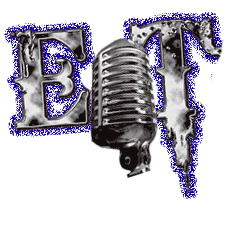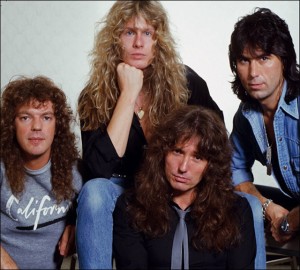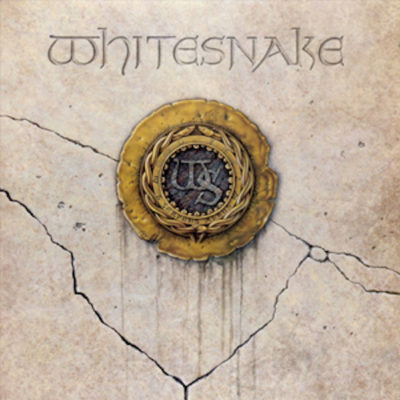Martin Kielty of Ultimate Classic Rock reports:
Many debut albums are self-titled because the music you hear is the artist’s statement of intent. Others self-title releases later in their career because the music represents a definitive achievement.
David Coverdale got it absolutely spot-on when he called Whitesnake’s seventh album Whitesnake because it was indeed a definitive achievement – released in 1987 after almost everything that could go wrong had gone wrong.
Work on the follow-up to 1984’s Slide It In had begun the following year with the band’s eighth lineup since its formation in 1978. Coverdale, who’d endured fractious interactions with most of his previous colleagues, had established a close working relationship with Thin Lizzy guitarist John Sykes. Together with bassist Neil Murray and drummer Aynsley Dunbar, they began laying down tracks in Vancouver … which is where the project began to go off the rails.
“I got a dreadful sinus infection – which was not drug-related – and it cost me all my vocal ability, If there’s supposed to be any there,” Coverdale told Headbangers Ball. “I had to go in for surgery, and I said to the members of the group that there was no guarantee I’d get my voice back. I suggested that they find another band.”
He later recounted how he’d realized there was a problem as he tried to record Is This Love, “I sang the song from beginning to end, out of tune, and I couldn’t tell. At the end of it, I was dripping with sweat, and it’s not an exhausting song to perform.” He was given 50-50 odds of being able to sing again after doctors described his infection as the worst they’d ever seen. A course of antibiotics had appeared to resolve it, until a week after he’d gone back to work, when the problem had returned.
Coverdale was sidelined for eight months, during which time he became “mortified” at Sykes’ alleged attempts to wrest the project from the singer’s control. “I received no support from Sykes at that time,” he told In the Studio With Redbeard. “He did everything he could to take advantage of me being compromised.” In the meantime, the singer “tried to come to terms with the idea I could still write, I could still produce, but someone else would be singing my songs.”
By the time he felt ready to try again, he was “the only snake in residence,” left with the instrumental material that had already been laid down. He admitted his first studio session had him “indescribably nervous.” New producer Keith Olsen asked him to sing Still of the Night, claiming that it wouldn’t be recorded. “I almost vomited,” Coverdale recalled. “I sang the song twice, fingers crossed – and that’s what’s on the record.”
While the album was back on track, Whitesnake were, by that time, $3 million in debt; and Coverdale didn’t even know if there was a place for his band on the world stage, since groups like Bon Jovi and Europe had taken over the charts since his last release. Worse, he didn’t even have a band to place on that world stage.
“I’d written out the names of Adrian Vandenberg, Vivian Campbell, Rudy Sarzo and Tommy Aldridge,” he said later. “If I was getting a band together, these were the people I thought would be good – Viv to recreate the American guitar hero, Adrian to play more traditional guitar and Rudy and Tommy, who we’d approached to be the rhythm section on the album.”
Some of those men contributed finishing touches to Whitesnake, but Coverdale remained cautious and would only describe them as “on call” during the LP’s release. He referred to them as “The Vid Kids” when they appeared in the videos for the songs Still of the Night, Here I Go Again and Is This Love – promos, recorded over a fortnight, which also featured ‘80s actress and entertainer Tawny Kitaen. She was dating the singer at the time, and later, briefly, became his wife.
Whitesnake was released on April 7th, 1987, and renamed 1987 in Europe and Australia, and Serpens Albus in Japan. Even though it stalled at the number two spot on the U.S. Billboard 200, it stayed there for months, notching up five million sales while other albums came and went. Current total sales are more than 15 million.
Those figures were powered in no small way by the three hit singles, including the number one revamped version of Here I Go Again, which had originally appeared on 1982 LP Saints & SInners. Revisiting a five-year-old song – alongside Crying in the Rain, also from Saints & Sinners – might suggest a level of introspective reflection on the leader’s part. He seemed to agree when he told Redbeard that those songs had been “documenting professional dissatisfaction and private sadness.”
A reasonable way to be feeling if you suspect your performing career may be over in the lead-up to the release of what might be your final record. But it wasn’t. Whitesnake defined post-blues Coverdale and every lineup of the band that followed.
It wasn’t all good news, though. Admitting he’d “got tired of seeing myself on MTV,” Coverdale said “the only downside was it was the only time I’d embraced a fashion presentation, as opposed to being stylized in what I do. I think that disappointed a lot of my hardcore people – the Americanization of Whitesnake.”
It almost certainly did; but it managed to please many more other people.
source: ultimateclassicrock.com




8 Responses
I`m calling his story 90% bs, makes no sense to me. I got a sinus infection guys better find a new band,lol. C`mon dude. Also if I wanted to get a guitarist that has that american guitar hero sound I wouldn`t get a dude from Ireland,lol . I think we all know the real story.
He can say what he wants about the situation between him and John Sykes, but the fact remains that Sykes rules on that album right alongside Coverdale does. I like the first Blue Murder album much more than the follow-up to the 1987 Whitesnake album that they made with Steve Vai, “Slip Of The Tounge”.
Vivian Campbell should have stayed with Dio. I know his relationship with Ronnie had broken down, but Dio was still a better fit for him than Whitesnake. I read an interview with Ronnie in Hit Parader back when Vivian first left where Ronnie said Vivian wanted more exposure and he wanted more attention. Ronnie went on to say how ridiculous that was considering Vivian joined Whitesnake, didn’t play on the album they were touring for and had to share guitar duties with Adrian Vandenberg.
I bought the LP, then the cassette, then the CD, and finally the download. The first three tracks are absolute killers. Crying in the Rain was so good I can’t listen to the original with critiquing it to death. Still of the Night is still to this day one of my favorite songs and is one of the greatest Hard Rock/Metal songs ever.
The irony that Sykes gets literally no credit for his work on this album is very interesting. They both have different versions of the story and the truth is in the middle. Sykes is one of my favorite players, but has a history of being a little squirrelly (Dana my most humblest of apologies). However his solos on that album…I just can’t say enough.
Sinus infections can be a real intense bitch. I’ve had several and one that was so bad my doctor sent me to my dentist to have my back teeth shaved down so they wouldn’t touch and reduce the pain so I could sleep. If he had to have surgery I can only imagine his scenario.
DR,
That is perfectly okay, while my love for Sykes knows no bounds, he is human and not infallible to making errors in judgment.
Also, my apologies on your past sinus infections, how horrible. My mother caught one on an airplane, which are cess pools for recirculated bacterium, anyway, and she could not get rid of it after seeing three doctors and many rounds of antibiotics. By the time she visited the fourth ENT, either it was on it’s way out, or he prescribed the right drug, because she finally got better. So my heart goes out to you, sinus infections can be really awful.
Finally, speaking of Crying in The Rain and Still of the Night? What do you think of Sykes’ versions? If you have not heard them, I included the links below.
Crying in The Rain: https://www.youtube.com/watch?v=cIPCmo1VM0g
Still of the Night: https://www.youtube.com/watch?v=bQrWIMAITcI
D 🙂
Dana,
That album Bad Boy Live by Sykes is absolutely killer!
I just recently discovered this thanks to Eddie Trunk on the Monday show a couple/few months ago.
I’m hearing this great live Thin Lizzy sounding song I was unfamiliar with, Cold Sweat.
Thankfully, Eddie explains it’s Sykes on a live album that’s out of print and very hard to find.
So begins the mission to track down this CD. Find it on eBay, and eventually get the Japanese import at a reasonable price. Fantastic!
Was never really exposed to Thin Lizzy back in the day. Chicago radio blows, all we ever got was Boys Are Back In Town and Jailbreak. Now, I get what a great band they were, and influential to others (including Def Lep).
I have been into the Black Star Riders from the start, again thanks to Eddie.
Bottom line, you can still find great “new” music. Sometimes it’s older stuff that slipped through the cracks or never got the deserving promotion.
Mikey,
I am so glad you that you discovered that release and enjoy it. It makes my Sykes heart fill with pride. 🙂
D 🙂
I could wax poetic about Bad Boy Live like a senior citizen but I’ll try and keep it brief. As much as I love Sykes as a player, he’s not one of my favorite vocalists. The Blue Murder stuff works because of the studio work. Having said that, the tone of his guitar on Bad Boy Live is just so unmistakably him it’s crazy. Only Lynch and Rhoads seemingly can/could repeat live what you hear in the studio. Yngwie is kinda like that too. But he just goes all over the fret board live and I lose interest. Crying In the Rain is by far the better track on BBL, as his solo essentially mirrors what you hear on Whitesnake. His left and right hands are working overtime to recreate that solo. It’s flawless. Still of the Night is harder for a four piece and an average vocalist to pull off. It’s still a good version. But Cryin’ is the better track. Thanks for sharing Dana. It’s been a long time since I listened to those tracks. I just closed my office door and threw it on Bluetooth. It took me back about 30 years.
DR,
Glad you enjoyed it. 🙂
As for Sykes as a vocalist, that is okay. It is hard to find, what Eddie calls, the “triple threat” (great guitarist, great vocalist and great songwriter). We both happen to think that Sykes, and Richie Kotzen, qualify in that category, but certainly, understand that not everyone will agree.
Funny enough, months before its release, I read in Metal Edge magazine that John was going to be singing lead on Blue Murder. I was a bit concerned because I had no idea what to expect, and did not want to have any reason to think less of him, or his talent. So for me, it was a complete relief, once I did hear his voice. I happen to really like it, but again, I understand, that not everyone will. Unlike Coverdale’s smoky, sexy bluesy tone, Sykes’ is sweeter, clearer and much more reminiscent of Thin Lizzy’s Phil Lynott.
Anyway, I am so pleased that you put him the company of such luminaries as Rhoads and Lynch. You literally listed my top three favorite guitar players of all time. Rhoads being one, Sykes two, and Lynch three.
Have a great day and all my best,
D 🙂